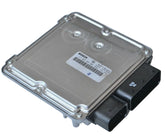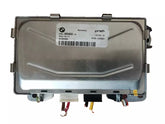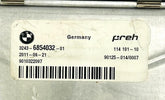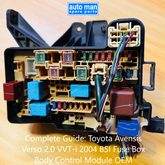TL;DR — Key takeaways
-
The Engine Control Unit (ECU) is the onboard computer that manages fuel, timing, an d emissions for modern engines.
-
About 98% of new U.S. vehicles used ECUs by 2024, so ECU health matters for most drivers (source: Automotive News).
-
ECUs process millions of calculations per second from 30+ sensors and directly affect power, fuel economy, and emissions.
-
Common failures stem from sensor faults, wiring issues, and software glitches; repair versus replacement depends on diagnosis and vehicle value.
-
Replacement options include new, remanufactured, and used units; programming, VIN matching, and immobilizer checks are essential.
One-sentence definition
An Engine Control Unit (ECU) is a compact digital computer that reads sensor inputs and commands engine actuators to optimize performance, efficiency, and emissions.
1) What is an Engine Control Unit and why is it essential?
The ECU is the engine’s electronic brain and it keeps the engine running correctly. It collects inputs, runs control logic, and sends commands to injectors, coils, and valves. Because roughly 98% of new U.S. cars use ECUs, a faulty unit affects drivability, fuel economy, and emissions compliance. Owners should care because an ECU failure can trigger a Check Engine light and lead to failed emissions tests or unsafe running behavior.
2) How does an ECU work? sensors, data, and actuators
An ECU reads sensors, runs calculations, and controls actuators in real time. It samples dozens of inputs, applies maps and algorithms, and adjusts fuel, timing, and idle control. Modern units perform millions of calculations per second and commonly receive data from 30+ sensors. That flow looks like this: sensors → ECU → actuators (injectors, ignition, idle valve).
Common sensor inputs the ECU uses
-
Mass Air Flow (MAF) / Manifold Absolute Pressure (MAP)
-
Oxygen (O2) / Lambda sensors
-
Coolant Temperature (ECT)
-
Intake Air Temperature (IAT)
-
Crankshaft and Camshaft Position
-
Throttle Position Sensor (TPS)
-
Fuel Rail Pressure / Injector current
-
Knock sensor
-
ABS/VSS signals (in integrated powertrain controllers)
-
Battery voltage and cranking data
Tip: Clear, corrosion-free connectors help accurate sensor readings and stable ECU performance.
3) ECU vs ECM vs PCM: what’s the difference in practice?
Those acronyms all point to engine-control hardware but with slight scope differences. An ECU often means a module focused on engine functions. An ECM (Engine Control Module) is synonymous. A PCM (Powertrain Control Module) combines engine and transmission control. Technicians and brands use terms interchangeably, so check the vehicle’s wiring and diagnostics rather than relying on the label.
4) How does the ECU affect fuel efficiency and emissions?
The ECU optimizes air-fuel ratio and ignition timing to improve economy and reduce pollutants. It uses O2 sensor feedback to trim fuel delivery and maintain stoichiometry. Accurate ECU control directly influences emissions systems like catalytic converters and EGR, which affects regulatory compliance in inspections.
5) Symptoms of an ECU problem you should not ignore
ECU problems show as drivability faults and warning lights. Common symptoms include: Check Engine light, poor acceleration, stalling, rough idle, decreased fuel economy, intermittent no-start, and harsh shifting when the ECU manages the transmission. Diagnostic Trouble Codes (DTCs) often point to sensors or communication faults rather than the ECU itself, so careful testing is required.
6) Diagnosing and troubleshooting ECU problems (step-by-step)
Start by reading OBD-II codes and work toward hardware checks. Steps: retrieve codes, inspect sensors and harnesses, verify power and ground, test data-bus integrity, check software version and TSBs, consider reflash, then decide repair or replacement. A structured diagnostic flow avoids unnecessary ECU swaps. If tests point to wiring or sensor failure, fix that first before replacing the module.
7) Repair vs. replacement: what to know in 2025
Decide based on cost, availability, and compatibility. New OEM ECUs give peace of mind but cost more. Remanufactured units save money but must match part numbers and calibrations. Used ECUs are lowest cost but risk compatibility and software mismatches. Programming requirements can force a dealer visit for some models.
8) Upgrades and tuning: can an ECU be upgraded for better performance?
Yes, ECUs can be reprogrammed or swapped for aftermarket units for performance gains. Gains come from altered fuel maps and timing. Be aware of emissions laws and warranty impacts. Use reputable tuners and maintain emissions controls where required.
9) Real-world use cases: ECU in action
Examples show ECU decisions in everyday driving. During heavy acceleration, the ECU enriches fuel. Knock detection triggers timing retard to protect the engine. O2 sensor feedback corrects a lean or rich condition and may set a DTC. These examples show how sensor data leads to immediate corrective actions.
10) Cost and replacement options in the United States (2025 snapshot)
Prices vary widely by make and model. New OEM ECUs often range from several hundred to over a thousand dollars. Remanufactured units sit in the mid-range, and used units are cheapest. Labor and programming add to total installed cost. For shopping, use reputable sellers and verify part numbers and VIN compatibility — a good catalog example is AutomAn Spare Parts’ ECU collection (see their ECU listings).
11) How to buy or replace an ECU: a buyer’s guide
Verify exact part numbers, VIN compatibility, and immobilizer needs. Ask if the unit is tested and if programming or VIN cloning is required. Remanufactured units often include warranties. For catalog variety and stock checks, review the AutomAn catalog which lists thousands of ECUs and shipping options.
12) Maintenance and care to extend ECU life
Keep electrical connections clean and use a healthy battery. Replace corroded grounds and avoid DIY hacks that bypass safety features. When manufacturers offer software updates, apply them at a trusted shop to maintain stability.
13) Safety, legal, and warranty considerations
Improper ECU work can affect safety systems and emissions compliance. Unauthorized tuning may void warranties and fail inspections. Always document software changes and confirm legal compliance with local emissions rules.
14) FAQ
What is the ECU in a car?
An ECU is the vehicle’s electronic controller that manages engine functions by reading sensors and commanding actuators.
How does an ECU improve fuel efficiency?
It continuously adjusts fuel and timing using sensor feedback to maintain optimal combustion and economy.
Can an ECU be repaired, or must it be replaced?
Some ECUs can be repaired at component level, but many diagnostics-first approaches replace the module only after ruling out sensors and wiring.
How much does ECU replacement cost?
Costs range from a few hundred dollars for a remanufactured unit to over $1,000 for new OEM parts, plus programming and labor.
What’s the difference between ECU, ECM, and PCM?
They are similar controllers; PCM often includes transmission control, while ECU/ECM typically focus on engine management.
Do modern ECUs require dealer programming?
Some do, especially where immobilizer or VIN cloning is required, though many independent shops can program units too.
How can I tell if my ECU is failing?
Look for persistent DTCs, erratic engine behavior, and tests that show stable sensor readings when wiring and sensors are known good.
Can ECU upgrades void my warranty?
Altering ECU programming often voids warranties and may affect emissions compliance.
15) Real-life example (brief)
A 2016 sedan stalled and threw fuel-trim faults. Technicians replaced a failing O2 sensor, re-flashed the ECU calibration, and restored fuel economy and drivability.
Quick summary
The Engine Control Unit governs engine behavior, emissions, and economy through rapid sensor-driven decisions. As of August 2025, ECUs remain central to vehicle performance and repair decisions. When facing ECU-related symptoms start with diagnostics, check sensors and wiring, and confirm programming needs before buying a replacement. For parts and stock options, review catalogs such as AutomAn’s ECU collection and consult trusted service providers.
Sources and further reading
-
Automotive News summary on vehicle electronics adoption: https://www.autonews.com
-
Automotive Service Association guidance on diagnostic trends: https://www.asashop.org
-
AutomAn spare parts ECU listings: https://automanspareparts.com/collections/ecu-engine-control-units







